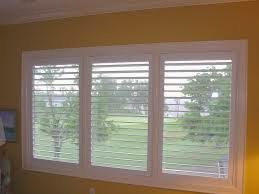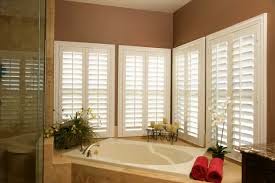Plantation Shutters - What They Are, the Different Types and Their History
About Plantation Shutters
Shutters of varying types have been in use now throughout the world for over 100 years. Historically utilized as a protection mechanism against inclement weather, their function was to guard against the adverse effects of the sun, wind or rain dependent upon location and prevailing conditions.
In warmer climes it is common to see the fully closed shutter located on the exterior of a building. When closed this would guard against the heat of the sun and also protect against strong winds and dust storms.
In other locations, these same shutters would be used to protect against the effects of rainstorms, wind, seawater and corrosion.
What are Plantation Shutters?
Plantation Shutters are shutters made up of louvered slats. This feature allows for the regulation of sunlight, temperature, ventilation and privacy and also offers some protection against the elements. Popular as a practical solution to any of the above, plantation shutters have also become widely used as for aesthetic purposes, adding style and individuality to the facade of a building.
The Different Styles of Plantation Shutter
Plantation shutters are available in many different styles, shapes and sizes and they can be fitted either to the inside or outside of a window aperture.
Full Cover or Full Height Shutters
As the name suggests, a full cover or full height shutter will cover the entire window pane. Full height window shutters allow you to regulate lighting and ventilation whilst also increasing privacy and security. This type of shutter can be used in any room of the house and looks particularly impressive when fitted to both ground and first floor windows. Their simple styling and elegance easily transforms a building to the pinnacle of chic.
Cafe style Plantation Shutters
A Cafe style louver shutter covers just the bottom half of a window frame. As such it maximises the amount of light available whilst still providing the required amount of privacy. They are equally useful on both ground and first floors, lending understated elegance to the facade of any building. Popularised by French cafes and bars, Cafe style plantation shutters can be created in both louvered and solid panel styles, and come in a range of finishes including natural and painted wood.
Tier on Tier Shutters
A Tier on Tier Shutter is effectively a full height shutter, split into two sections with an upper tier and a lower tier. This allows one to be opened whilst the other remains closed and is ideal for maintaining privacy whilst at the same time, allowing in plenty of natural light.
The History of Plantation Shutters
Originating in America and the West Indies and dating back to before the American Civil War, the plantation shutter with its distinctive louvers was used widely in the large plantation houses, which needed protection from the sun but also wanted the benefits of a cooling breeze.
Since then, its popularity both as a utilitarian fixture and as a style statement has grown and their appeal now is almost worldwide.
Nowadays, a wide range of shutters is available for use both, internally or externally. They provide an attractive alternative to blinds and are particularly suited to homes in built up areas where maintaining privacy without compromising on natural light is important.
Shutters of varying types have been in use now throughout the world for over 100 years. Historically utilized as a protection mechanism against inclement weather, their function was to guard against the adverse effects of the sun, wind or rain dependent upon location and prevailing conditions.
In warmer climes it is common to see the fully closed shutter located on the exterior of a building. When closed this would guard against the heat of the sun and also protect against strong winds and dust storms.
In other locations, these same shutters would be used to protect against the effects of rainstorms, wind, seawater and corrosion.
What are Plantation Shutters?
Plantation Shutters are shutters made up of louvered slats. This feature allows for the regulation of sunlight, temperature, ventilation and privacy and also offers some protection against the elements. Popular as a practical solution to any of the above, plantation shutters have also become widely used as for aesthetic purposes, adding style and individuality to the facade of a building.
The Different Styles of Plantation Shutter
Plantation shutters are available in many different styles, shapes and sizes and they can be fitted either to the inside or outside of a window aperture.
Full Cover or Full Height Shutters
As the name suggests, a full cover or full height shutter will cover the entire window pane. Full height window shutters allow you to regulate lighting and ventilation whilst also increasing privacy and security. This type of shutter can be used in any room of the house and looks particularly impressive when fitted to both ground and first floor windows. Their simple styling and elegance easily transforms a building to the pinnacle of chic.
Cafe style Plantation Shutters
A Cafe style louver shutter covers just the bottom half of a window frame. As such it maximises the amount of light available whilst still providing the required amount of privacy. They are equally useful on both ground and first floors, lending understated elegance to the facade of any building. Popularised by French cafes and bars, Cafe style plantation shutters can be created in both louvered and solid panel styles, and come in a range of finishes including natural and painted wood.
Tier on Tier Shutters
A Tier on Tier Shutter is effectively a full height shutter, split into two sections with an upper tier and a lower tier. This allows one to be opened whilst the other remains closed and is ideal for maintaining privacy whilst at the same time, allowing in plenty of natural light.
The History of Plantation Shutters
Originating in America and the West Indies and dating back to before the American Civil War, the plantation shutter with its distinctive louvers was used widely in the large plantation houses, which needed protection from the sun but also wanted the benefits of a cooling breeze.
Since then, its popularity both as a utilitarian fixture and as a style statement has grown and their appeal now is almost worldwide.
Nowadays, a wide range of shutters is available for use both, internally or externally. They provide an attractive alternative to blinds and are particularly suited to homes in built up areas where maintaining privacy without compromising on natural light is important.
The Bespoke Shutter Company supply and install a full range of
blinds and shutters in North London and the home counties, including plantation shutters, solid shutters, and cedar shutters,
and Venetian and vertical blinds. We have established our reputation by
being committed to the highest levels of craftsmanship along with the
use of only the best products available. Our plantation shutters are
available in a range of solid and engineered woods of the highest
quality. Please contact us now to book your free home consultation.
Article Source:
http://EzineArticles.com/?expert=Rachel_Manning
















